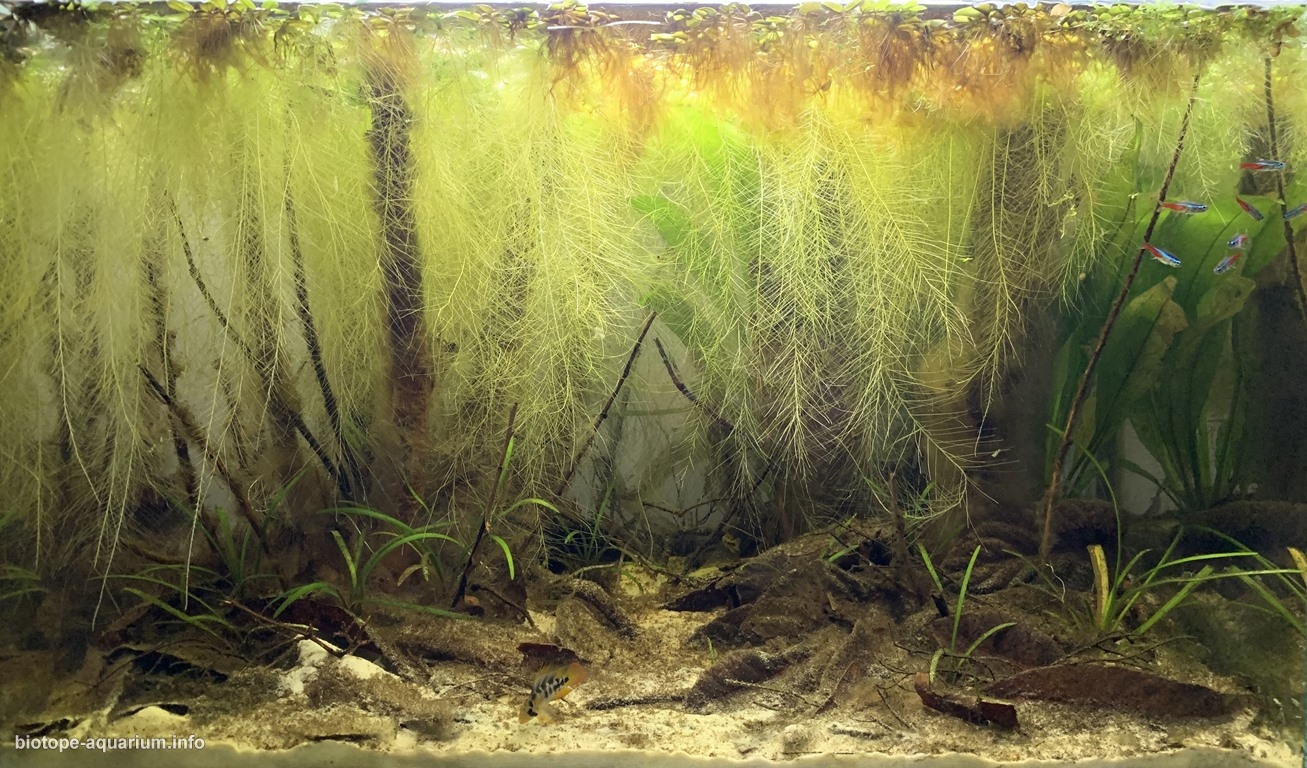Huallaga River Floodplain Small Forest Stream, Yurimaguas, Peru
_th place in Biotope Aquarium Design Contest 2020

Volume: 96 liters
Dimensions: 60x40x40
List of fishes: Apistogramma baesnchi (inka), Paracheirodon innesi
List of plants: Sagittaria subulata, Echinodorus peruensis, Pistia stratiotes, Salvinia natans
Description of decorations: Roots and branches placed to represent the forest flood, white fine sand similar to the habitat in the lower ground, small pieces of branches and abundant leaves were used. The materials are similar to the habitat.
Description of equipment: External filter: Sunsun hbl 802, 100 watt heater, Mygos plant series 35 watt 7500k ledlight
Water parameters: 25 ° C temperature, 6.8 pH, 42 ppm, 3 gh, 2 kh water values
Additional info: 15% of routine water changes and maintenance are done weekly. Nitrate values are kept very low. Plants also contribute a lot to the nitrogen cycle.
INFORMATION ABOUT BIOTOPE:
Description of the area surrounding the biotope: The Huallaga River is a tributary of the Marañón River, part of the Amazon Basin. Old names for this river include Guallaga and Rio de los Motilones. The Huallaga is born on the slopes of the Andes in central Peru and joins the Marañón before the latter reaches the Ucayali River to form the Amazon. Its main affluents are the Monzón, Mayo, Biabo, Abiseo and Tocache rivers. Coca is grown in most of those valleys, which are also exposed to periodic floods.
Although it runs for 700 miles (1,100 km), it remains unnavigable for most part.[2] For nearly its entire length the Huallaga is an impetuous torrent running through a succession of gorges. It has forty-two rapids (pongos) and it crosses the Andes, forming the Pongo de Aguirre gorge. From this point, 140 miles (230 km) from the Amazon, the Huallaga can be ascended by larger river boats (lanchas) to the port city of Yurimaguas, Loreto.
Although there are no defined boundaries, the river is commonly divided into two or three sections. From the town of Tocache in San Martin to the source of the river is generally referred to as the Upper Huallaga. Regions of the river are also referred to as central Huallaga (usually from Tocache or Juanjui to Chazuta), and the lower Huallaga (usually from Chazuta to Yurimaguas where the Huallaga meets the Marañon). These divisions are for general reference, and are independent of the “highland” and “lowland” jungle regions of the Amazon Rainforest.
Between the Huallaga and the Ucayali lies the famous “Pampa del Sacramento,” a level region of stoneless alluvial lands covered with thick, dark forests, first entered by Christian missionaries in 1726. It is about 300 miles (480 km) long, from north to south, and varies in width from 40 to 100 kilometers. Many streams, navigable for canoes, penetrate this region from the Ucayali and the Huallaga. In addition to peasants, it is still occupied by many indigenous communities, such as the Cocama-Cocamilla.
Description of the underwater landscape of the biotope: The Huallaga River flows relatively above 1000 meters above sea level. Forest streams are covered with a layer of white sand that is poor in minerals. Small streams feature blackwater. It is a weak area in terms of aquatic flora. There are abundant stranded driftwood, wood and leaf deposits on the floor.
Description of the parameters of the habitat: The main tributary of the Huallaga River is generally slightly polluted throughout the year. Small ponds or streams formed as a result of tributaries and floods feeding this river are stained with blackwater or light tannin. According to the rainy and dry seasons, the temperature varies between 22-30 ° C, pH 5.0-7.0, conductivity 0-50 microsiemens.
List of fishes and invertebrates occurring in the nature biotope: Apistogramma baenschi, Apistogramma agassizi, Apistogramma cacatouides other Apistogramma species, Pterophyllum scalare, Nannostomus morthenthaleri, nannostomus sp., Laetacara thayeri, Bujurquina huallagae, Carnegiella myersi, Hyphessobrycon peruvianus, Paracheirodon innesi. Corydoras sp, Lamontichthys filamentosa,
List of plants found in the nature biotope: Echinodorus peruensis, Echinodorus sp., Eleocharis sp. Limnobium laevigatum, Sagittaria subulata, Pistia stratiotes
Threats to the ecology: The river and the riversides suffer point source pollution, utilized as an interminable garbage dump. At least one chute for garbage trucks is installed.
The Huallaga River supports a myriad of wildlife and vegetation. The river is especially rich in amphibian life. A total of 18 species of frogs have been recorded from it, including the Prostherapis femoralis, Phyllodromus pulchellus and Dendrobates reticulatus.
Since the 1980s, the primary coca growing and drug trafficking activities in Peru have been in the Upper Huallaga Valley. [1]
The coca is flown to Colombia, where it is used to create cocaine, which is subsequently shipped to the United States.
Vladimiro Montesinos, ex-head of Peru’s intelligence service, is reported to have received $50,000 for every plane laden with drugs allowed to leave the Huallaga Valley.
Sources of information:
https://en.wikipedia.org/wiki/
http://www.druglibrary.org/
Youtube and instagram ptohos, videos
